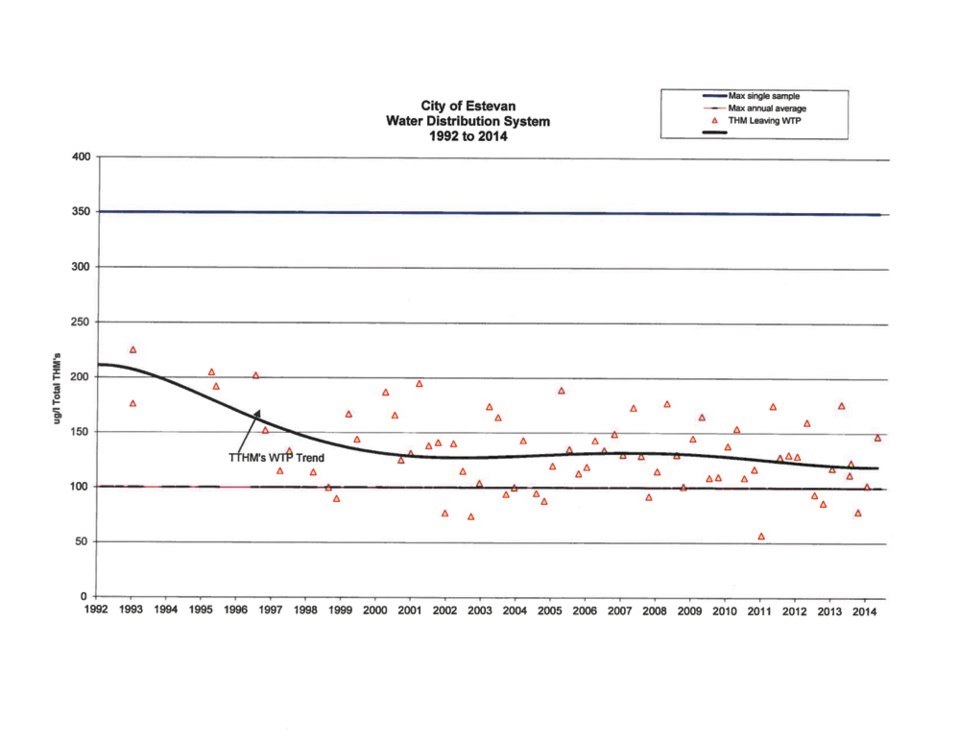Estevan’s wastewater treatment system is operating at peak capacity, and as the annual wastewater and water quality reports for 2014 noted, the system is regularly operating beyond its capacity.
With the wastewater treatment plan going online in 1996, the system was designed for a maximum daily flow of 6,000 cubic metres per day. Wastewater treatment plant manager Kevin Sutter’s report on 2014, published earlier this month, found that system operated past that flow 26 days last year. A chart submitted by Sutter showed daily spikes beyond 7,000 cubic metres and even one beyond 8,000 metres in September.
Sutter has said continuing to operate at the treatment plant at the current level is similar to running the system like a car at full speed.
“The things that are broken down on it will show up a lot faster than if you’re idling along,” Sutter said.
To alleviate that, city council, when the 2015 budget was approved, passed a motion to move forward with a plan that will invest millions of dollars in the City’s water and wastewater infrastructure.
For wastewater, Sutter noted the City provides SaskPower with effluent through a lagoon system. The City takes the entire wastewater collection flow and processes it using a process called biological nutrient removal, activated sludge process.
The City discharges that treated effluent to holding cells and over the summer months, SaskPower removes the effluent by pumping from Holding Cell J. The waste sludge produced by these processes is de-watered and disposed of at the landfill.
Sutter noted the City is required to maintain an effluent quality that leaves Cell J.
Construction was completed on the biosolids building last year, and the equipment involved in the de-watering process will be purchased and installed this year, with the expectation that the entire plant will be operational sometime in the summer.
Sutter said the City is expecting to work more closely with SaskPower during any future upgrades to the wastewater treatment plant, as they use the effluent for cooling purposes. The process at the moment requires the effluent to be stored for 180 days, and Sutter said the parties are looking at eliminating the lengthy process, which would save the City form having to expand the lagoon cells.
Sutter also submitted a water quality report based on readings gathered over the course of 2014.
As has previously been the case, the City’s water complied with the majority of regulations, except for those that set a limit on the total trihalomethanes (TTHM), which were above the maximum 100 parts per billion allowed. Last year’s average was 113 parts per billion.
High TTHM levels are something the City has been dealing with for years. The average concentration of TTHMs dropped from above 200 in the early 1990s but leveled off to about 120 around 2000 and have been roughly unchanged since.
TTHMs are created when free chlorine comes into contact with carbon-based organics and are regulated because of the possible carcinogenic properties the compounds hold.
With the City unable to get the concentration below the maximum threshold through other means, there are plans to draw water from the Rafferty Reservoir.
With fewer dissolved organic carbons in Rafferty’s water, running a pipeline from Rafferty is expected to allow the City to meet the regulatory requirements.
That project is one the City has applied for under the New Building Canada Fund, and if it is accepted Sutter said the new intake could be completed as early as the end of 2016.
The water quality report noted that the Wellock Reservoir, which went online in October 2013, has increased the stored treated water in the City to two days of average use. The reservoir has also given the City a sufficient water supply to continue ongoing development in the North part of the city where there is still a lot of new residential work planned.




